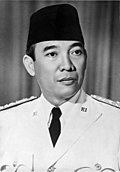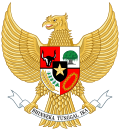Ampera Cabinet Kabinet Ampera | |
|---|---|
| 26th Cabinet of Indonesia | |
| 1966–1967 | |
 | |
| Date formed | 28 July 1966 |
| Date dissolved | 11 October 1967 |
| People and organisations | |
| Head of state | |
| Head of government | Suharto |
| No. of ministers | 30 ministers |
| Member party | |
| History | |
| Predecessor | Dwikora III Cabinet |
| Successor | Ampera II Cabinet |
| ||
|---|---|---|
Pre-independence Domestic policy Foreign policy Family Media and legacy | ||
The Ampera Cabinet [1] (Indonesian : Kabinet Ampera) was the Indonesian cabinet which served under President Sukarno and later on acting president Suharto from July 1966 until October 1967. [2] The cabinet was formed after the Provisional People's Consultative Assembly (MPRS) session of 1966 which commissioned Suharto to form a new cabinet. [3] Although Sukarno would not be removed from the presidency for some months, for all intents and purposes, the person who was truly in charge of the cabinet, and Indonesia by this point, was Suharto.
Contents
- Cabinet leader
- Cabinet Presidium
- Ministers in the Field of Defence and Security
- Ministers in the Field of Political Affairs
- Ministers in the Field of People's Welfare
- Ministers in the Field of Economics and Finance
- Ministers in the Field of Industry and Development
- Changes
- References
- Notes
- External links



